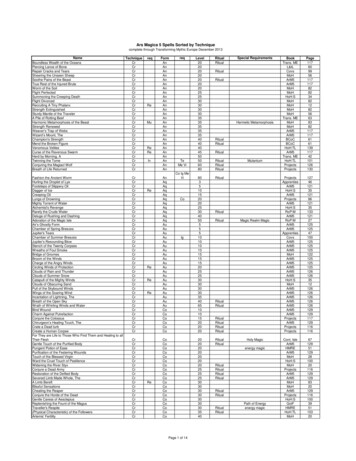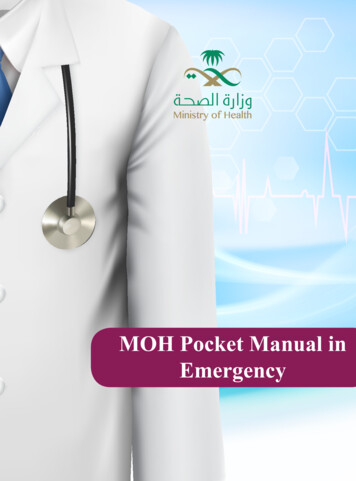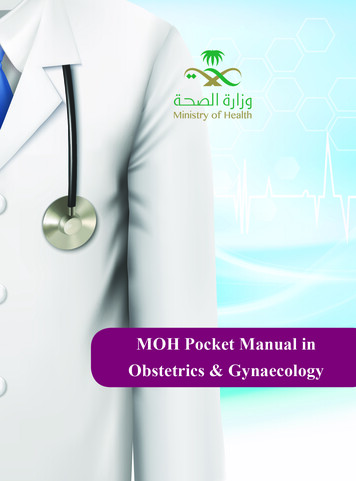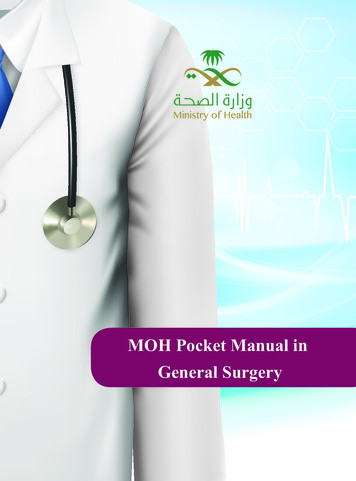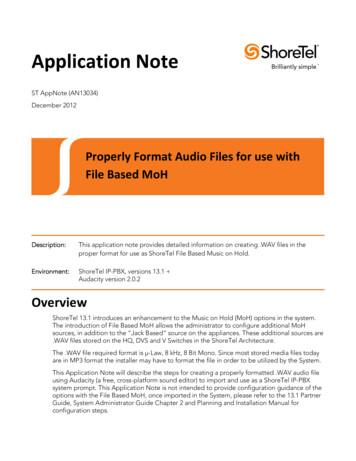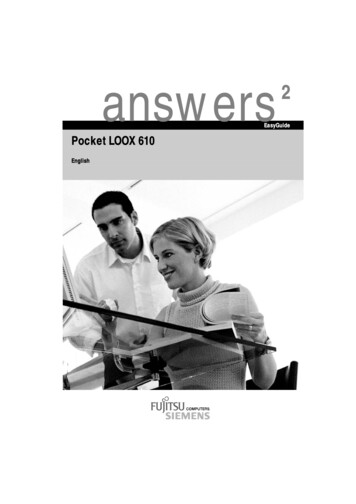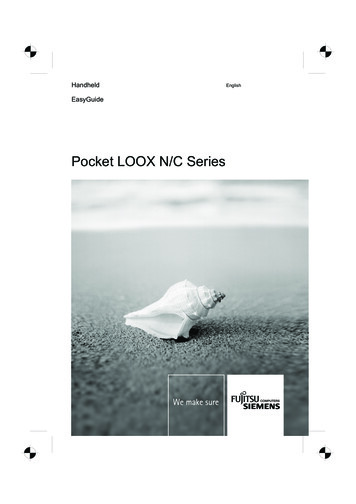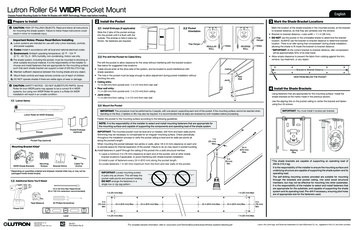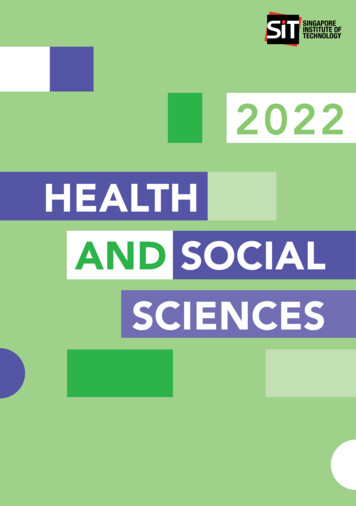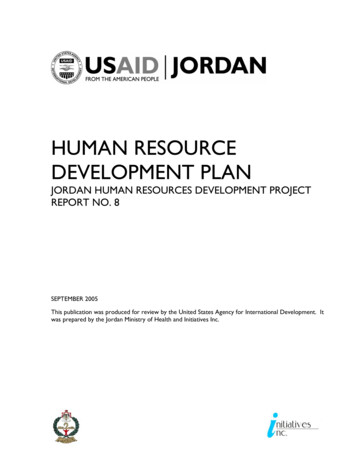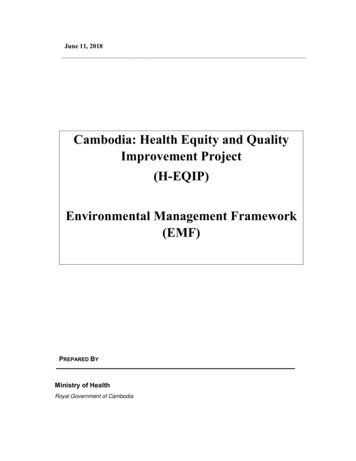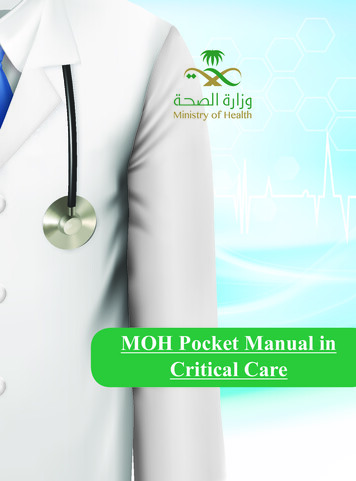
Transcription
MOH Pocket Manual inCritical Care
MOH Pocket Manual in Critical CareTABLE OF CONTENTSINTRACRANIAL HEMORRHAGE9ISCHEMIC STROKE910TRAUMATIC BRAIN INJURY1111CNS INFECTION1512STATUS EPILEPTICUS1813GUILLIAN-BARˊ́RÉ SYNDROME2114MYASTHENIA GRAVIS2315HYPERTENSIVE CRISIS2616ACUTE CORONARY SYNDROME2917VENTICULAR TACHYCARDIA 3518SUPRAVENTRICULAR TACHYCADIA3919BRADYARRHYTHMIAS4220HEART FAILURE 4321SHOCK 4522ACUTE EXACERBATION OF CHRONIC OBSTRUCTIVEPULMONARY DISEASE4823STATUS ASTHMATICUS24ACUTE RESPIRATORY DISTRESS SYDROME25PNEUMONIA26PULMONARY EMBOLISM27CHEST TRAUMA28MECHANICAL VENTILATION29GASTROINTESTINAL BLEEDING30VARICEAL BLEEDING403
MOH Pocket Manual in Critical CareACUTE LIVER FAILURE ALF50HEPATIC ENCEPHALOPATHY60ACUTE PANCREATITIS80ACUTE MESENTERIC ISCHEMIA (BOWEL ISCHEMIA)81INTESTINAL PERFORATION/OBSTRUCTION82COMPARTMENT SYNDROMES83ACUTE RENAL FAILURE84RHABDOMYOLYSIS85DISSEMINATED INTRAVASCULAR COAGULATION (DIC)86SICKLE CELL CRISIS87SEPTIC SHOCK88ANAPHYLAXIS89SEVERE YPERKALAEMIA101HYPOKALAEMIA102HYPERGLYCEMIC HYPEROSMOTIC STATE (HHS)103HYPOGLYCEMIADKA104THYROTOXIC CRISIS105MYXEDEMA COMA106DISORDERS OF TEMPERATURE CONTRO107OPIOID POSITIONING108ORGANOPHOSPHATE POISONING1094
MOH Pocket Manual in Critical CarePARACETAMOL POISONING110INHALED POISONING CO150ALCOHOL TOXICITY151REFERENCES125ALPHAPITICAL DRUG INDEX3355
MOH Pocket Manual in Critical CareIntracranial hemorrhageOverview The pathological accumulation of blood within the cranialvault) may occur within brain parenchyma or the surrounding meningeal spaces. Intracerebral hemorrhage accounts for8-13% of all strokes and results from a wide spectrum of disorders. Intracerebral hemorrhage is more likely to result in deathor major disability than ischemic stroke or subarachnoid hemorrhage. Intracerebral hemorrhage and accompanying edemamay disrupt or compress adjacent brain tissue, leading to neurological dysfunction. Substantial displacement of brain parenchyma may cause elevation of intracranial pressure (ICP) andpotentially fatal herniation syndromes. Causes of Intracranial hemorrhage :-6Possible causes are as follows:HypertensionArterio-Venous malformationAneurysmal ruptureIntracranial neoplasmCoagulopathyHemorrhagic transformation of an ischemic infarctCerebral venous thrombosis
MOH Pocket Manual in Critical Care-Sympathomimetic drug abuseSickle cell diseaseInfectionVasculitisTraumaClinical Presentation History:Onset of symptoms of intracerebral hemorrhage isusually during daytime activity, with progressive (i.e, minutes to hours) development of the following:- Alteration in level of consciousness (approximately50%)Nausea and vomiting (approximately 40-50%)Headache (approximately 40%)Seizures(approximately 6-7%)Focal neurological deficitsPhysical: Clinical manifestations of intracerebral hemorrhage are determined by the size and location of hemorrhage,but may include the following:-Hypertension, fever, or cardiac arrhythmiasNuchal rigidityRetinal hemorrhagesAltered level of consciousnessFocal neurological deficits7
MOH Pocket Manual in Critical Care-PutamenContralateral hemiparesis, contralateral-ThalamusContralateral sensory loss, contralater--LobarContralateral hemiparesis or sensory loss,-Caudate nucleusContralateral hemiparesis, con--Brain stemQuadriparesis, facial weakness, de--CerebellumAtaxia, usually beginning in thesensory loss, contralateral conjugate gaze paresis,homonymous hemianopia, aphasia, or apraxia.al hemiparesis, gaze paresis, homonymous hemianopia, miosis, aphasia, or confusioncontralateral conjugate gaze paresis, homonymoushemianopia, abulia, aphasia, neglect, or apraxiatralateral conjugate gaze paresis, or confusioncreased level of consciousness, gaze paresis, ocular bobbing, miosis, or autonomic instabilitytrunk, ipsilateral facial weakness, ipsilateral sensory loss, gaze paresis, skew deviation, miosis, ordecreased level of consciousnessWork Up Laboratory Studies-8Complete blood count (CBC) with platelets: Monitorfor infection and assess hematocrit and platelet count to
MOH Pocket Manual in Critical Careidentify hemorrhagic risk and complications. -Prothrombin time (PT)/activated partial thromboplastintime (aPTT): Identify a coagulopathy.-Serum chemistries including electrolytes and osmolarity: Assess for metabolic derangements, such as hyponatremia, and monitor osmolarity for guidance of osmoticdiuresis.-Toxicology screen and serum alcohol level if illicit druguse or excessive alcohol intake is suspected: Identifyexogenous toxins that can cause intracerebral hemorrhage.-Screening for hematologic, infectious, and vasculiticetiologies in select patients: Selective testing for moreuncommon causes of intracerebral hemorrhage.Parenchymal imaging-CT scan: readily demonstrates acute hemorrhage as-MRI: appearance of hemorrhage on conventional T1hyperdense signal intensity. Multifocal hemorrhages atthe frontal, temporal, or occipital poles suggest a traumatic etiology.and T2 sequences evolves over time because of chemical and physical changes within and around the hematoma9
MOH Pocket Manual in Critical Care Vessel imagingCT angiography permits screening of large and-MR angiography permits screening of large and-Conventional catheter angiography definitive-medium-sized vessels for AVMs, vasculitis, and other arteriopathies.medium-sized vessels for AVMs, vasculitis, and other arteriopathies.ly assesses large, medium-sized, and sizable smallvessels for AVMs, vasculitis, and other arteriopathies.Consider catheter angiography for young patients,patients with lobar hemorrhage, patients without ahistory of hypertension, and patients without a clearcause of hemorrhage who are surgical candidates.Angiography may be deferred for older patients withsuspected hypertensive intracerebral hemorrhage andpatients who do not have any structural abnormalitieson CT scan or MRI. Timing of angiography dependson clinical status and neurosurgical considerations.Procedures-10-Ventriculostomy allows for external ventriculardrainage in patients with intraventricular extensionof blood products. Intraventricular administration ofthrombolytics may assist clot removal.
MOH Pocket Manual in Critical CareManagement Medical Care:Medical therapy of intracranial hemorrhage is principallyfocused on adjunctive measures to minimize injury and tostabilize individuals in the perioperative phase.-Perform endotracheal intubation for patients withdecreased level of consciousness and poor airwayprotection.-Cautiously lower blood pressure to a mean arterialpressure (MAP) less than 130 mm Hg, but avoidexcessive hypotension. Early treatment in patientspresenting with spontaneous intracerebral hemorrhage is important as it may decrease hematomaenlargement and lead to better neurologic outcome.-Rapidly stabilize vital signs, and simultaneouslyacquire emergent CT scan.-Intubate and hyperventilate if intracranial pressureis increased; initiate administration of mannitol forfurther control.-Maintain euvolemia, using normotonic rather thanhypotonic fluids, to maintain brain perfusion with11
MOH Pocket Manual in Critical Careout exacerbating brain edema. -Avoid hyperthermia.-Correct any identifiable coagulopathy with freshfrozen plasma, vitamin K, protamine, or platelettransfusions.-Initiate fosphenytoin or other anticonvulsant definitely for seizure activity or lobar hemorrhage, andoptionally in other patients.-Facilitate transfer to the operating room or ICU.Medications Summary :Antihypertensive agents reduce blood pressure toprevent exacerbation of intracerebral hemorrhage. Osmoticdiuretics, such as mannitol, may be used to decrease intracranial pressure. As hyperthermia may exacerbate neurological injury, paracetamol may be given to reduce feverand to relieve headache. Anticonvulsantse.gphentoynare used routinely to avoid seizures that may be induced bycortical damage. Vitamin K and protamine may be usedto restore normal coagulation parameters. Antacids areused to prevent gastric ulcers associated with intracerebralhemorrhage.12
MOH Pocket Manual in Critical CareSurgical Care : -Consider nonsurgical management for patients withminimal neurological deficits or with intracerebral hemorrhage volumes less than 10 mL.-Consider surgery for patients with cerebellar hemorrhage greater than 2.5 cm, for patients with intracerebral hemorrhage associated with a structural vascularlesion, and for young patients with lobar hemorrhage.-Other surgical considerations include the following:--Clinical course and timing-Elevation of ICP from hydrocephalus-Patient’s age and comorbid conditions-Etiology-Location of the hematoma-Mass effect and drainage patternsSurgical approaches include the following:-Craniotomy and clot evacuation under directvisual guidanceStereotactic aspiration with thrombolyticagentsEndoscopic evacuation13
MOH Pocket Manual in Critical Care14
MOH Pocket Manual in Critical CareIschemic StrokeOverview Ischemic stroke is characterized by the sudden loss of bloodcirculation to an area of the brain, resulting in a correspondingloss of neurologic function. Acute ischemic stroke is causedby thrombotic or embolic occlusion of a cerebral artery and ismore common than hemorrhagic stroke.Clinical Presentation Consider stroke in any patient presenting with acute neurologic deficit or any alteration in level of consciousness. Commonstroke signs and symptoms include the following:-Abrupt onset of hemiparesis, monoparesis, or (rarely)quadriparesisHemisensory deficitsMonocular or binocular visual lossor Visual field deficitor DiplopiaFacial droopAtaxia or Vertigo (rarely in isolation) or NystagmusAphasia or DysarthriaSudden decrease in level of consciousness15
MOH Pocket Manual in Critical CareWork Up Emergent brain imaging is essential for confirming the diagnosis of ischemic stroke. Noncontrast computed tomography (CT)scanning is the most commonly used form of neuroimaging inthe acute evaluation of patients with apparent acute stroke. Thefollowing neuroimaging techniques are also used:-CT angiography and CT perfusion scanningMagnetic resonance imaging (MRI)Carotid duplex scanningDigital subtraction angiographyLaboratory studiesLaboratory tests performed in the diagnosis and evaluationof ischemic stroke include the following:16-Complete blood count (CBC): A baseline study thatmay reveal a cause for the stroke (eg, polycythemia,thrombocytosis, thrombocytopenia, leukemia) or provide evidence of concurrent illness (eg, anemia)-Basic chemistry panel: A baseline study that may reveal a stroke mimic (eg, hypoglycemia, hyponatremia)or provide evidence of concurrent illness (eg, diabetes,renal insufficiency)
MOH Pocket Manual in Critical Care-Coagulation studies: May reveal a coagulopathy andare useful when fibrinolytics or anticoagulants are to beused-Cardiac biomarkers: Important because of the association of cerebral vascular disease and coronary arterydisease-Toxicology screening: May assist in identifying intoxicated patients with symptoms/behavior mimickingstroke syndromes-Arterial blood gas analysis: In selected patients withsuspected hypoxemia, arterial blood gas defines theseverity of hypoxemia and may be used to detect acid-base disturbancesManagement The goal for the emergent management of stroke is to complete the following within 60 minutes of patient arrival:-Assess airway, breathing, and circulation (ABCs) andstabilize the patient as necessary-Complete the initial evaluation and assessment, including imaging and laboratory studies-Initiate reperfusion therapy, if appropriateCritical treatment decisions focus on the following:17
MOH Pocket Manual in Critical Care-The need for airway management-Optimal blood pressure control ( less than 180/110 ) 18Identifying potential reperfusion therapies (eg, intravenous fibrinolysis with rt-PA or intra-arterial approaches)Ischemic stroke therapies include the following:-Fibrinolytic therapy-Antiplatelet agents-Statins-ACEI & ARBS-Mechanical thrombectomyTreatment of comorbid conditions may include the following:-Reduce fever-Correct hypotension/significant hypertension-Correct hypoxia-Correct hypoglycemia-Manage cardiac arrhythmias-Manage myocardial ischemia
MOH Pocket Manual in Critical CareTraumatic Brain InjuryOverview Often referred to as TBI, is most often an acute eventsimilar to other injuries. Brain injuries do not heal like other injuries. Recovery is a functional recovery Pathophysiology:A. Primary brain Injury — Primary brain injury oc-curs at the time of trauma. Common mechanisms include direct impact, rapid acceleration/deceleration,penetrating injury, and blast waves. Although thesemechanisms are heterogeneous, they all result from external mechanical forces transferred to intracranial contents. The damage that results includes a combinationof focal contusions and hematomas, as well as shearingof white matter tracts (diffuse axonal injury) along withcerebral edema and swelling.-Shearing mechanisms lead to diffuse axonal injury(DAI), which is visualized pathologically and on neuroimaging studies as multiple small lesions seen withinwhite matter tracts-Focal cerebral contusions are the most frequently encountered lesions.-Extra-axial hematomas are generally encountered whenforces are distributed to the cranial vault and the most19
MOH Pocket Manual in Critical Caresuperficial cerebral layers. These include epidural, subdural, and subarachnoid hemorrhage.-Intraventricular hemorrhage is believed to result fromtearing of subependymal veins, or by extension fromadjacent intraparenchymal or subarachnoid hemorrhage.B. Secondary brain Injury — Secondary brain injuryin TBI is usually considered as a cascade of molecularinjury mechanisms that are initiated at the time of initialtrauma and continue for hours or days. These mechanisms include ical injury to cell membranes-Electrolyte imbalances-Mitochondrial dysfunction-Inflammatory responses-Apoptosis-Secondary ischemia from vasospasm, focal microvascular occlusion, vascular injury.causeThese lead in turn to neuronal cell death as well as tocerebral edema and increased intracranial pressure that can furtherexacerbate the brain injury.20
MOH Pocket Manual in Critical CareCLASSIFICATION: Clinical severity scores — TBI has traditionally An alternative scoring system, the Full Outline of UnResponsiveness (FOUR) Score, has been developed inorder to attempt to obviate these issues, primarily byincluding a brainstem examination. However, this lacksthe long track record of the GCS in predicting prognosisand is somewhat more complicated to perform, whichmay be a barrier for nonneurologists. Neuroimaging scales — Traumatic brain injury can-Skull fractureEpidural hematomaSubdural hematomaSubarachnoid hemorrhageIntraparenchymal hemorrhageCerebral contusionbeen classified using injury severity scores; the mostcommonly used is the Glasgow Coma Scale (GCS). AGCS score of 13 to 15 is considered mild injury, 9 to 12is considered moderate injury, and 8 or less as severetraumatic brain injury. However, it is limited by confounding factors such as medical sedation and paralysis, endotracheal intubation, and intoxication.lead to several pathologic injuries, most of which can beidentified on neuroimaging:21
MOH Pocket Manual in Critical Care-Intraventricular hemorrhageFocal and diffuse patterns of axonal injury with cerebraledemaTwo currently used CT-based grading scales are theMarshall scale and the Rotterdam scale.Management INTENSIVE CARE MANAGEMENTA. General medical care —22-Maintenance of BP (systolic 90 mmHg) and oxygenation (PaO2 60 mmHg) remain priorities in the management of TBI patients in the ICU. These should becontinuously monitored. Isotonic fluids (normal saline)should be used to maintain euvolemia.-The prevention of deep venous thrombosis (DVT) is adifficult management issue in TBI. Patients with TBIare at increased risk of DVT which can be reduced bythe use of mechanical thromboprophylaxis using intermittent pneumatic compression stockings. While DVTrisk can be further reduced with antithrombotic therapy, this has to be weighed against the potential risk ofhemorrhage expansion, which is greatest in the first 24to 48 hours.-Nutritional support should not be neglected in TBI.
MOH Pocket Manual in Critical CareUnder-nutrition is associated with higher mortality. Patients should be fed to full caloric replacement by dayseven.-TBI patients are at risk for other complications (eg, infection, gastrointestinal stress ulceration), which can bereduced by appropriate interventions.B. Intracranial pressure control— Elevated intracranial pressure is associated with increased mortality and worsened outcome. Initial treatment and ICP monitoring — several-approaches are used in the intensive care setting to prevent and treat elevated ICP. Simple techniques shouldbe instituted as soon as possible:-Head of bed elevation to 30 degrees.-Optimization of venous drainage: keeping theneck in neutral position, loosening neck braces iftoo tight.-Monitoring central venous pressure and avoidingexcessive hypervolemia.Indications for ICP monitoring in TBI are a GCS score 8 and an abnormal CT scan showing evidence of mass23
MOH Pocket Manual in Critical Careeffect from lesions such as hematomas, contusions, orswelling .24-ICP monitoring in severe TBI patients with a normal CTscan may be indicated if two of the following featuresare present: age 40 years; motor posturing; systolic BP 90 mmHg. A ventricular catheter connected to a straingauge transducer is the most accurate and cost-effective method of ICP monitoring and has the therapeuticadvantage of allowing for CSF drainage to treat risesin ICP.-Most guidelines and clinical protocols recommend thattreatment for elevated ICP should be initiated when ICPrises above 20 mmHg. Ventricular drainage is generally attempted first. CSF should be removed at a rate ofapproximately 1 to 2 mL/minute, for two to three minutes at a time, with intervals of two to three minutes inbetween until a satisfactory ICP has been achieved (ICP 20 mmHg) or until CSF is no longer easily obtained.Slow removal can also be accomplished by passivegravitational drainage through the ventriculostomy.-If ICP remains elevated, other targeted interventionsinclude osmotic therapy, hyperventilation, and sedation. In refractory cases, barbiturate coma, inducedhypothermia, and decompressivecraniectomy may beconsidered.
MOH Pocket Manual in Critical Care-Osmotic therapy — The intravascular injection of-Hyperventilation — Most patients with severe TBI-Sedation — Sedative medications and pharmacologi--Cerebral perfusion pressure —While optimizationhyperosmolar agents (mannitol, hypertonic saline)creates an osmolar gradient, drawing water across theblood-brain barrier This leads to a decrease in interstitial volume and a decrease in ICP.are sedated and artificially ventilated during the firstseveral days. Regarding ICP management, control ofventilation helps prevent increases in intrathoracicpressure that may elevate central venous pressures andimpair cerebral venous drainage. (Keeping the PaCO2between 35-40).cal paralysis are often used in patients with severe headinjury and elevated ICP. The rationale is that appropriate sedation may lower ICP by reducing metabolicdemand. Sedation may also ameliorate ventilator asynchrony and blunt sympathetic responses of hypertension and tachycardia. These possible beneficial effectsare counterbalanced by the potential for these drugs tocause hypotension and cerebral vasodilation that in turnmay aggravate cerebral hypoperfusion and elevate ICP.of CBF is a foundation of TBI treatment, bedside measurement of CBF is not easily obtained. Cerebral perfusion pressure (CPP), the difference between the meanarterial pressure (MAP) and the intracranial pressure:CPP MAP - ICP, is a surrogate measure. Episodes of25
MOH Pocket Manual in Critical Carehypotension (low MAP), raised ICP, and/or low CPPare associated with secondary brain injury and worseclinical outcomes.26-An early approach to induce hypertension to target CPP 70 mmHg using volume expansion and vasopressoragents appeared to reduce mortality and morbidity.While patients with more severely impaired autoregulation in particular may be more likely to respond toefforts to lower ICP than to hypertensive-focused CPPtherapy.-Antiepileptic drugs — The incidence of earlypost-traumatic seizures (within the first week or two)is about 6 to 10 percent but may be as high as 30 percent in patients with severe TBI. The use of antiepileptic drugs (AEDs) in the acute management of TBI hasbeen shown to reduce the incidence of early seizures,but does not prevent the later development of epilepsy.We use the following approach to seizure managementin patients with severe TBI:-Use a seven-day course of prophylactic phenytoinor valproic acid-Do not use AED prophylaxis long-term-Consider EEG and/or EEG monitoring in patientswith coma-Treat both clinical and electrographic-only sei-
MOH Pocket Manual in Critical Carezures with AEDs-Temperature management — Fever worsens-Glucose management — Both hyper- and hypogly--Hemostatic therapy —The systemic release of tis--ADVANCED NEUROMONITORING — Inoutcome after stroke and probably severe head injury, presumably by aggravating secondary brain injury.Current approaches emphasize maintaining normothermia through the use of antipyretic medications, surfacecooling devices, or even endovascular temperaturemanagement catheters.cemia are associated with worsened outcome in a variety of neurologic conditions including severe TBI.sue factor and brain phospholipids into the circulationleading to inappropriate intravascular coagulation &a consumptive coagulopathy. Coagulation parametersshould be measured in the emergency department in allpatients with severe TBI and efforts to correct any identified coagulopathy should begin immediately.order to supplement ICP monitoring, several technologies have recently been developed for the treatmentof severe TBI. These techniques allow for the measurement of cerebral physiologic and metabolic parametersrelated to oxygen delivery, cerebral blood flow, and metabolism with the goal of improving the detection andmanagement of secondary brain injury.27
MOH Pocket Manual in Critical CareCNS infectionOverview An infection of the central nervous system may primarily affect its coverings, which is called meningitis. Itmay affect the brain parenchyma, called encephalitis, oraffect the spinal cord, called myelitis. The nervous system may also suffer from localized pockets of infection.Within the brain or spinal cord there may be an abscess .Commonbacterialpathogens2-50 yearsAntimicrobial therapyN. meningitidis, S. pneu- Vancomycin plus a third-generamoniaetion cephalosporinS. pneumoniae, N. 50 yearsmeningitidis, L.Vancomycin plus ampicillin plusmonocytogenes, aerobica third-generation cephalosporingram-negative bacilliHead traumaS. pneumoniae, H. influBase skull fracture enzae, group A beta-hemolytic strept.28Vancomycin plus a third-generation cephalosporin
MOH Pocket Manual in Critical CareStaphylococcus aureus,c o a g u l a s e - n e g a t i v e Vancomycin plus cefepime; ORPenetrating mycin plus ceftazidime; ORepidermidis), aerobic G vancomycin plus meropenem–vebacilliVancomycin plus cefepime; ORAerobic gram-negative vancomycin plus ceftazidime; ORbacilliPost-neurosurgery(includingP. vancomycin plus meropenemaeruginosa), S. aureus,coagulase-negativestaphylococci (especially S. epidermidis)S. pneumoniae, N.meningitidis, L.Immunocompro- monocytogenes, aerobicmised stategram-negative bacilli(including P. aerugi-Vancomycin plus ampicillin pluscefepime; OR vancomycin plusampicillin plus meropenemnosa)29
MOH Pocket Manual in Critical CareBacterial (septic) meningitis30 Clinical Presentation-Early in the course of the illness, the patient with apurely meningeal infection will be awake, and painfully aware of his symptoms, so you may simply askhim about them. Later in the illness, if untreated, themeningeal inflammation will have led to diffuse braindysfunction, ischemia or infarction, and the patient willbe stuporous.-The classic signs of meningeal infection are fever, stiffneck (meningismus), and headache. Although characteristic of meningitis, headache and meningismus mayoccur in other infections, such as pneumonia. Photophobia, nausea, vomiting, malaise and lethargy arecommon. The latter are also common in “functional”headaches like migraine, and may confuse the unwaryphysician.-Meningeal signsThe stiff neck that occurs in menin-gitis is often striking--it is really stiff, almost boardlike,but not so painful as it is stiff. It is greatest with flexion,less with extension or rotation. Associated with the stiffneck are two other classic “meningeal signs”, the signsof Kernig and Brudzinski. Brudzinski’s sign is involuntary flexion of the hip and knee when the examinerflexes the patient’s neck. Kernig’s sign is limitation ofstraightening of the leg with the hip flexed. Meninge-
MOH Pocket Manual in Critical Careal signs occur not only in infectious meningitis, but insubarachnoid hemorrage and chemical meningitis. Unfortunately, meningismus occurs only in about 50% ofcases of bacterial meningits, so the sign is neither highly specific nor highly sensitive.Work UpSuspicious clinical symptoms and signs. CT of head to rule out abscess or other space-occupying lesion Blood cultures. Lumbar puncture for CSF analysisGlucose (mg/dl) 1010-45Protein (mg/dl) 25050-250Total WBC (cell/microL) terialViralbacterialViralT.B.Somecases ofmumpsEncephalitis5-100Early BacterialViralEncephalitis31
MOH Pocket Manual in Critical CareManagement Empiric antimicrobial therapy for purulent meningitis Dosages for adults with bacterial meningitis with normalrenal and hepatic functionAntimicrobial agentDose (adult)Ampicillin2 g every 4 hoursCefepime2 g every 8 hoursCefotaxime2 g every 4 to 6 hoursCeftazidime2 g every 8 hoursCeftriaxone2 g every 12 hoursMeropenem2 g every 8 hoursPenicillin G potassiumVancomycin324 million units every 4hours15 to 20 mg/kg every 8 to12 hours‡
MOH Pocket Manual in Critical CareStatus EpilepticusOverview Status epilepticus is defined usually as a condition inwhich epileptic activity persists for 30 min or more. Theseizures can take the form of prolonged seizures or repetitive attacks without recovery in between. The physiological changes in status can be divided intotwo phases, the transition from phase 1 to 2 occurringafter about 30–60 minutes of continuous seizures. Inphase 1, compensatory mechanisms prevent cerebraldamage. In phase 2, however, these mechanisms breakdown, and there is an increasing risk of cerebral damageas the status progresses. The cerebral damage in statusis caused by systemic and metabolic disturbance (forexample, hypoxia, hypoglycaemia, raised intracranialpressure) and also by the direct excitotoxic effect ofseizure discharges (which result in calcium influx intoneurons and a cascade of events resulting in necrosisand apoptosis). EpidemiologyAcute insults to the brain, including meningitis, encephalitis, head trauma, hypoxia,hypoglycemia, drug intoxication or withdrawal, tumor-Chronic epilepsy or febrile convulsions.33
MOH Pocket Manual in Critical Care-New-onset epilepsy.Work Up Emergency investigations-Emergency investigations should include assessment ofthe following: blood gases, glucose, renal and hepaticfunction, calcium, magnesium, full blood count, clotting screen, and anticonvulsant concentrations. Serumshould be saved for toxicology or virology or other future analyses. An electrocardiogram (ECG) should beperformed.-Frequent or even continuous EEG monitoring until seizures activities subside .ManagementCardiorespiratory function -In all patients presenting in status, the protection of cardiorespiratory function takes first priority.Hypoxia is usually much worse than appreciated, andoxygen should always be administered.34
MOH Pocket Manual in Critical Care Initial emergency treatment-emergency intravenous antiepileptic drug treatment-maintenance antiepileptic drugs orally or via a nasogastric tube-intravenous thiamine and glucose if there is the possibility of alcoholism-glucose if hypoglycaemia is present-the correction of metabolic abnormalities if present-the control of hyperthermia-pressor therapy for hypotension if present-the correction of respiratory or cardiac failure.-If the status is caused by drug withdrawal, the withdrawn drug should be immediately replaced, by parenteral administration if possible. Treatment may alsobe needed for cardiac dysrhythmia, lactic acidosis (ifsevere), rhabdomyolysis, or cerebral oedema (in latestatus).Protocol of Treatment of Status Epilepticus : Red Flag All infusion rates should be adjusted to individual pa35
MOH Pocket Manual in Critical Caretients; maximum doses are not always required.36 Cardiac monitoring required. Phenytoin or fosphenytoin may be ineffective for toxin-induced seizures and may intensify seizures caused by cocaine and other local anesthetics, theophylline, or lindane. Patients with toxin-induced .seizuresshould receive phenobarbital, midazolam, or propofolinfusion as second line therapy.
MOH Pocket Manual in Critical CareGuillain-Barré syndromeOverview GBS isan acute monophasic paralyzing illness provoked by a preceding infection.Clinical features-The cardinal clinical features are progressive, fairlysymmetric muscle weakness accompanied by absent ordepressed deep tendon reflexes. Patients usually present a few days to a week after onset of symptoms. Theweakness can vary from mild difficulty with walkingto nearly compl
- Elevation of ICP from hydrocephalus - Patient's age and comorbid conditions - Etiology - Location of the hematoma - Mass effect and drainage patterns - Surgical approaches include the following: - Craniotomy and clot evacuation under direct visual guidance - Stereotactic aspiration with thrombolytic agents - Endoscopic evacuation
